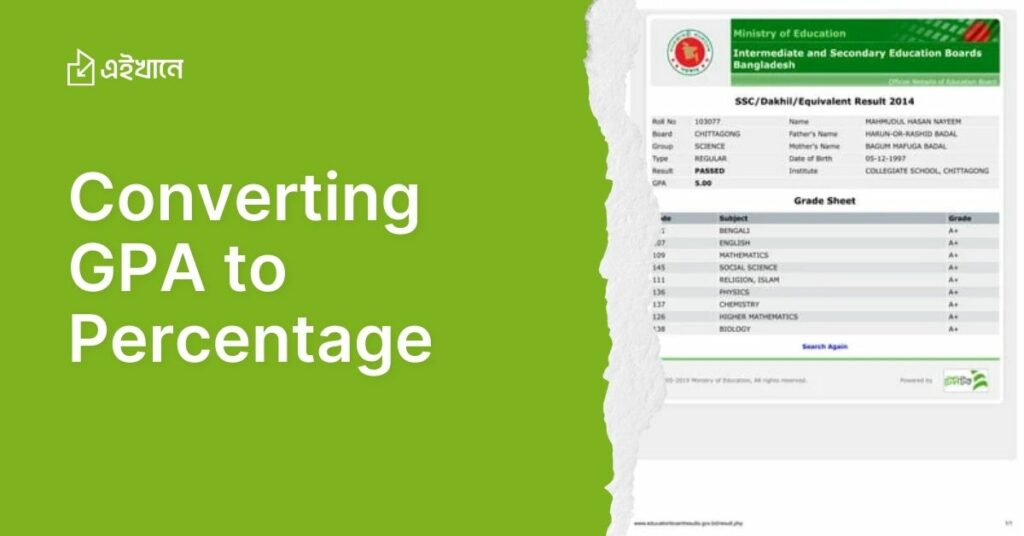How to Convert Your CGPA to Percentage: Essential Tips for Bangladeshi Students
Understanding the Grading System in Bangladesh
Before diving into the conversion process, it’s essential to understand the grading system in Bangladesh. Many universities and colleges use a 4.0 or 5.0 GPA (Grade Point Average) scale. Depending on your institution, the CGPA (Cumulative Grade Point Average) may be based on either of these systems. Typically, a CGPA is calculated as the weighted average of grades obtained in all courses, but students must know whether their institution uses a 4-point or 5-point system, as this directly influences the conversion into a percentage.
General Formula for Conversion
While there isn’t a universally accepted method for converting CGPA into a percentage, many universities in Bangladesh follow this simple formula: **Percentage = (CGPA/4.0) * 100** (for the 4-point scale) or **Percentage = (CGPA/5.0) * 100** (for the 5-point scale). This formula converts your CGPA into a percentage representation. Make sure you’re aware of the specific scale your university uses, as applying the incorrect formula can alter your cumulative results.
Institution-Specific Methods
Different educational institutions in Bangladesh may adopt slightly varied methods for converting CGPA into a percentage. Some universities have their own prescribed formulas, which can either adjust the scale or introduce additional factors. For example, some universities apply a multiplier like 9.5 or 9.8 for conversion. Always check with your university’s official guidelines or consult your academic adviser to ensure you use the correct formula.
Importance of Accurate Conversion
Converting your CGPA into percentage is especially important if you are applying for overseas education or specific job roles that require your academic grades in a particular format. Inaccurate conversions could lead to misunderstandings or false interpretations of your academic achievements. Therefore, always double-check your conversions and make sure you’re following the right method based on your university’s guidelines.
Using Online Tools for Verification
Several online tools are available for students who need to convert their CGPA quickly and accurately. Although manual calculations can work well, an online CGPA-to-percentage converter can help verify your result, ensuring there’s no room for mistakes. Be cautious when using such tools, however; ensure they align with the grading scheme of your specific institution.
Understanding the GPA to Percentage Conversion Scale in Bangladesh Education
The 4.0 and 5.0 GPA Scales
In Bangladesh, educational institutions primarily use two GPA scales: the 4.0 and 5.0 systems. The 4.0 scale is commonly applied in higher education such as universities, while the 5.0 scale is more frequently seen in secondary and higher secondary institutions. For students to accurately convert their GPA into a percentage, they must first identify which scale their educational institution follows. Misunderstanding this foundational step can lead to inaccurate percentage calculations.
How GPA is Calculated in Bangladesh
A student’s GPA in Bangladesh is calculated as a weighted average of their grades across all subjects or courses. Each grade corresponds to a specific numeric point, which is then averaged out over the entire academic term or year. For example, in the 4.0 system, an ‘A’ typically equals 4.0, while in the 5.0 system, an ‘A+’ often equals 5.0. Understanding these underlying values is critical for interpreting what your GPA represents before converting it into a percentage.
Percentage Equivalents in the 4.0 Scale
The 4.0 GPA system is straightforward when it comes to conversion into percentages. In this system, each GPA point increment corresponds to a particular range of percentages. For example, a GPA of 4.0 is often equivalent to 90-100%, indicating top performance, whereas a GPA of 3.0 might equate to 75-89%. The general conversion formula for the 4.0 scale is **Percentage = (GPA/4) * 100**, though some institutions may further refine these equivalencies locally.
Percentage Equivalents in the 5.0 Scale
For the 5.0 GPA system, the conversion process differs slightly but follows a similar principle. In this system, a GPA of 5.0 usually represents 90-100%, while a GPA of 4.0 could translate to approximately 80-89%. To convert a 5.0 scale GPA into a percentage, the formula is **Percentage = (GPA/5) * 100**. However, just as with the 4.0 scale, it’s important to double-check institutional guidelines because some schools might adjust these ranges based on internal grading standards.
Challenges of Converting Between Systems
Students often face challenges when converting between the 4.0 and 5.0 GPA scales, particularly when transferring between different types of educational institutions. Because the systems use different upper limits, direct comparison can sometimes be misleading. Before making any conversions, consult with academic advisors or institutional resources to ensure that your GPA-to-percentage conversion is accurate and appropriate to your context.
Why It’s Important to Know the Right Scale
Misinterpreting your GPA scale could affect applications to foreign universities, scholarship opportunities, or job placements. For example, if you’re applying to an overseas institution where they expect your results on a 4.0 scale, but you report them based on a 5.0 scale without conversion, it may appear that you have lower academic standing than you actually do. This underscores why understanding whether you’re using the 4.0 or 5.0 scale — and knowing how to accurately represent it as a percentage — is so crucial.
From CGPA to Percentage: A Simple Guide for Bangladesh University Students
Recognizing the Importance of CGPA for University Students
For university students in Bangladesh, your CGPA serves as a key representation of your academic performance. It not only affects your standing within the institution but can also significantly impact further education opportunities and job prospects. Employers or overseas universities often request percentage scores instead of CGPA, making it important to understand how to convert your CGPA accurately into a percentage.
Different Systems Across Universities
In Bangladesh, many universities operate on either the 4-point or 5-point grading system for calculating CGPA. This makes it vital for students to determine which system their respective institution uses. Universities such as Dhaka University or BRAC University tend to follow the 4.0 scale, while others may deviate slightly using unique conversion formulas or multipliers based on their internal guidelines. Make sure to verify with your institution’s academic office for the correct conversion method.
Step-by-Step CGPA to Percentage Conversion
The process of converting CGPA to percentage is quite straightforward once you are aware of your grading system. If your university follows the 4.0 CGPA scale, use the formula **Percentage = (CGPA/4) * 100**. For instance, if you have a CGPA of 3.6, your percentage would be **(3.6/4) * 100 = 90%**. Similarly, if you’re under the 5.0 scale, you can calculate your percentage by applying **Percentage = (CGPA/5) * 100**. Always cross-check for any additional factors your institution might include in the calculation.
Differences Between CGPA-Based and Course-Specific Percentages
One potential pitfall in converting CGPA to percentage is confusing overall CGPA-based percentages with course-specific percentage grades. Your CGPA reflects an aggregate of all your course results, weighted by the number of credit hours. Therefore, even if individual subjects provide percentage marks, the overall CGPA might not align directly with a simple average of those percentages. Understanding this distinction will help avoid errors when comparing CGPA to straight percentages.
Institution-Provided Conversion Charts
Some Bangladeshi universities offer official conversion charts or tables that outline the equivalent percentage for specific CGPA intervals. These tables typically remove any guesswork, providing exact correlations between CGPAs and percentages. For example, a CGPA between 3.5 and 3.75 might correspond to a 90-92% range according to some institutions. Always consult these resources if available from your university’s academic department.
Why Conversion Accuracy Matters Post-Graduation
After graduation, your CGPA-to-percentage conversion becomes highly relevant, especially if you’re seeking higher education abroad or applying for jobs that require candidates to list their academic scores in percentages. Reporting an incorrect percentage could negatively affect your application, diminishing your chances of being shortlisted. Whether using an official tool or manual calculation, ensure accuracy in your conversion to present your achievements reliably.
Handling Special Cases: Rounding and Cutoff Points
Certain situations may arise where your calculated percentage falls near a common cutoff point (e.g., 69.9% vs. 70%). In these cases, universities differ in their approach to rounding off percentages. Some institutions round up to the nearest whole number, while others might stick to the strict calculated number. Familiarize yourself with how your university manages these slight differences to avoid misunderstandings during the conversion process.
Calculating Your Academic Percentage from GPA: Bangladesh Education System Explained
Understanding GPA Calculation in Schools and Colleges
In the Bangladesh education system, GPA (Grade Point Average) is primarily used in schools and colleges for evaluating a student’s academic performance. For SSC (Secondary School Certificate) and HSC (Higher Secondary Certificate) results, the GPA scale out of 5.0 is commonly used. Each grade corresponds to a specific point value, with an ‘A+’ typically being equivalent to 5.0. The GPA is calculated as the weighted average of the student’s grades across different subjects, factoring in credit hours where applicable.
Converting GPA from School/College Levels to a Percentage
Once you have your GPA, you can easily convert it to a percentage by applying a standard formula. For the 5.0 scale used in SSC and HSC, the conversion can be done using **Percentage = (GPA/5) * 100**. This method gives you a direct percentage equivalent. For example, if your GPA is 4.5, your percentage would be **(4.5/5) * 100 = 90%**. This provides a clear representation of your academic achievements as a percentage, widely accepted by universities and employers.
Differences Between School-Level and University-Level GPA
It is important to note that the GPA-to-percentage conversion in schools and colleges based on the 5.0 scale differs from how GPAs are calculated at the university level, where institutions often use the 4.0 scale. Therefore, the formula **Percentage = (GPA/4) * 100** would apply at the university level. Using the wrong conversion formula when applying for university admission or job opportunities could lead to disparities, so always ensure you’re using the appropriate scale when making conversions.
Effect of Extra Credit and Subject Weighting
Different subjects in secondary and higher secondary education may carry varying weight, depending on the institution’s guidelines. Subjects like Mathematics and Science, which are considered core, may have more weight compared to electives. Therefore, the GPA you receive might already account for this weighting, affecting your overall percentage when converted. It’s essential to understand how these subject weightings influence your final GPA before proceeding with any conversions.
Challenges in Converting Graded Marks to GPA
At times, schools and colleges may provide percentage marks directly rather than GPA, especially for individual subjects. For students looking to convert back to GPA for reference, this can pose a challenge. Some institutions prescribe conversion tables or specific guidelines to help make this transition, but misinterpretations can occur if the process isn’t clear. Always consult with your school or academic board to ensure you’re converting your scores correctly when moving between percentages and GPAs.
The Role of Public Exam Boards in Grade Calculation
For SSC and HSC exams, the Bangladesh education system is governed by public exam boards such as the Dhaka Board, Chittagong Board, or Rajshahi Board. These boards oversee the grading system and determine the methodology for assigning GPAs to students based on their raw scores. Understanding how the board calculates these GPAs is crucial, as the grading curve might vary slightly from year to year, potentially affecting the GPA-to-percentage conversion for a particular batch of students.
Why Accurate Conversion is Crucial for Future Opportunities
Accurately converting your GPA into a percentage is essential when seeking further education abroad or applying for scholarships, especially since many international institutions want a percentage-based evaluation. Reporting incorrect scores due to inaccurate conversions could put your application at risk. Thus, whether you’re aiming for university admissions or job placements, ensure your GPA has been converted to a percentage correctly to reflect your true academic standing.
Master the Art of GPA-Percentage Conversion in Bangladesh Academic Context
Why Understanding the Context is Crucial
In Bangladesh, the academic system offers multiple grading scales that vary across different institutions and levels of education. Whether you’re transitioning from SSC/HSC to university or applying for a scholarship abroad, mastering the art of GPA-to-percentage conversion is essential. Often, overseas institutions and employers require your academic performance to be expressed as a percentage rather than a GPA. Knowing how to accurately convert your GPA, keeping in mind your institution’s specific guidelines, is important for presenting clear and correct academic results.
The Difference Between 4.0 and 5.0 GPA Systems
The major issue many students face is misunderstanding whether their grades are based on the 4.0 or 5.0 GPA scale, especially when moving between secondary and tertiary education. The 4.0 scale is more common at universities, while the 5.0 scale is mostly used in schools and colleges for SSC and HSC assessments. Each system has its own implications when it comes to conversion, so misinterpreting which scale you are on can lead to incorrect percentage calculations, affecting the way others view your academic achievements.
Common Conversion Formulas
Once you know the GPA scale being used by your institution, the next step is to apply a conversion formula. For the 4.0 GPA system, the most widely used calculation is **Percentage = (GPA/4) * 100**, while for the 5.0 system, the formula becomes **Percentage = (GPA/5) * 100**. These formulas provide a simple way to convert GPA to a percentage, but it’s crucial to verify whether your institution enforces additional factors or adjustments like grade multipliers, which could affect the final outcome.
Understanding Institutional Variations
Some Bangladeshi institutions have their own variations when it comes to calculating GPA and converting it into a percentage. For instance, certain universities might employ a fixed multiplier—like 9.5 or 10—to simplify the process, or they may use conversion tables that link GPA ranges to corresponding percentages. Always verify the exact conversion methods with your institution’s academic office to ensure your calculations meet the required standards and avoid discrepancies during vital applications.
Practical Examples of Conversion
To better understand the conversion process, let’s look at a few practical examples. Assume you’re using the 4.0 GPA scale and have a GPA of 3.7. Using the general formula, your percentage would be: **(3.7/4) * 100 = 92.5%**. On the other hand, if you’re working within the 5.0 GPA system and have a GPA of 4.4, applying the same logic gives you: **(4.4/5) * 100 = 88%**. These straightforward calculations help convert your GPA into a format required by many external organizations.
The Role of Grade Curves and Subject Weighting
In some educational settings, grade adjustments such as curving can also play a role in how GPA translates into a percentage. Additionally, subject weighting often affects the overall GPA. Core subjects like Mathematics and Science may carry heavier weight compared to electives. This weighting should be taken into account when computing your GPA, as it can influence the final percentage interpretation. Knowing this will help ensure a more precise conversion, particularly when GPA represents a series of weighted averages.
Double-Checking Your Results
Once you’ve performed your manual conversion, it’s always recommended to check your result using online conversion tools or calculators specifically calibrated for Bangladesh’s grading systems. However, be cautious—make sure the tool you’re using aligns with your academic institution’s guidelines. Many Bangladeshi universities now offer official GPA-to-percentage conversion charts or calculators, so referring to institutional resources ensures you’re presenting the most accurate information possible.
How Conversion Impacts International Applications
For students applying to institutions abroad, presenting your academic scores in the right format is critical. Many international universities rely on percentage rather than GPA for evaluating student applications, scholarships, and funding opportunities. Incorrectly converted percentages can severely affect your competitive standing. To prevent this, cross-check your conversion methods and results before submitting any applications.


